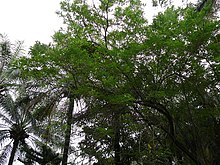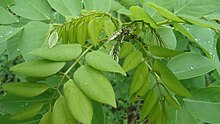Madre cacao
| Gliricidia sepium | |
|---|---|
 |
|
 |
|
| Scientific classification | |
| Kingdom: | Plantae |
| (unranked): | Angiosperms |
| (unranked): | Eudicots |
| (unranked): | Rosids |
| Order: | Fabales |
| Family: | Fabaceae |
| Genus: | Gliricidia |
| Species: | G. sepium |
| Binomial name | |
|
Gliricidia sepium (Jacq.) Kunth ex Walp. |
|
| Synonyms | |
|
|
Gliricidia sepium (Jacq.) Steud. Purdue University.
Gliricidia sepium, often simply referred to as Gliricidia (common names: quickstick, mata ratón; cacao de nance, cachanance; piñon Cubano in the Dominican Republic; madreado in Honduras; kakawate in the Philippines; madre xacao or madre de cacao in the Philippines and Guatemala; and madero negro in Nicaragua); wetahiriya in Sinhala ,is a medium size leguminous tree belonging to the family Fabaceae.
In many of these areas it is considered to be the second most important multi-purpose legume tree, surpassed only by Leucaena leucocephala.
Gliricidia sepium is a medium-sized tree that grows 10 to 12 meters high. The bark is smooth, and its color can range from a whitish gray to deep red-brown.
It has composite leaves that can be 30 cm long. Each leaf is composed of leaflets that are about 2 to 7 cm long and 1 to 3 cm wide.
The flowers are located on the end of branches that have no leaves. These flowers have a bright pink to lilac color that is tinged with white. A pale yellow spot is usually at the flower's base.
The tree's fruit is a pod about 10 to 15 cm long. It is green when unripe and becomes yellow-brown when it reaches maturity. The pod produces 4 to 10 round brown seeds.
G. sepium is native to tropical dry forests in Mexico and Central America. In addition to its native range it is cultivated in many tropical and subtropical regions, including the Caribbean, northern parts of South America, central Africa, parts of India, and Southeast Asia.
The tree grows well in acidic soils with a pH of 4.5-6.2. The tree is found on volcanic soils in its native range in Central America and Mexico. However, it can also grow on sandy, clay, and limestone soils.
...
Wikipedia
